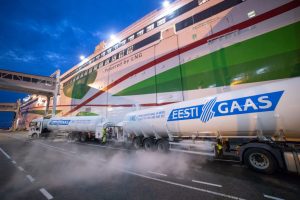LNG Fuel: Cruising improves its green credentials
Major cruise lines are improving their green credentials by switching to low-sulphur LNG fuel.
A cleaner fuel
The global shipping fleet consumes about 4 million barrels per day of high-sulphur fuel oil, and emits around 940 million tonnes of CO2 annually, making it a major contributor to greenhouse gas emissions. However, in 2020, new rules from the International Maritime Organisation (IMO) will come into force that cut the allowed sulphur content in marine fuel to 0.5 percent.
The new rules mean that vessels must either switch to fuels containing less than 0.5 percent sulphur, or install exhaust-cleaning systems (‘scrubbers’). Vessel operators can also meet the IMO 2020 standards by installing liquefied natural gas (LNG)-fuelled engines. LNG is the world’s cleanest burning fossil fuel, emitting nearly zero sulphur emissions.
Major cruise lines are switching
Three years ago, AIDA Cruises successfully demonstrated in a pilot project that a cruise ship can be powered by LNG. Just one year after that initial pilot, the AIDA Prima became the first cruise ship to routinely use LNG, switching to a dual-fuel powered engine while in port. This was particularly important, as cruise ships spend, on average, 40 percent of their operating time in port.
In December 2018, Carnival Corporation (owner of AIDA Cruises) launched its first, fully LNG-powered ship, the AIDA Nova, and has another 20 LNG-powered vessels scheduled for delivery by 2025.

Carnival-owned Costa Cruises has also joined the LNG club with their new LNG-powered flagship, the Costa Smeralda. The ship is being built by Meyer Werft shipyard in Turku, Finland, the same yard that built the AID Nnova. With a gross tonnage of over 180,000 tons and a 6,600 passenger capacity, the Costa Smeralda is scheduled to enter service in October 2019, with a 15-day inaugural cruise from Hamburg to Savona. Delivery of a twin to the Costa Smeralda, also being built by Meyer-Turku, is planned for 2021.
Not to be left out, in March 2019, Princess Cruises and shipbuilder Fincantieri signed contracts for the construction of two, next-generation 175,000-ton dual-fuelled cruise ships. The two vessels would be the largest ships ever built in Italy, with deliveries scheduled in late 2023 and spring 2025. MSC, Disney, Royal Caribbean and TUI Cruises have also all ordered LNG-powered new builds.
Pros and cons of LNG
The move to LNG has also received a boost from an unexpected source – President Donald Trump, whose bid to force a glut of LNG onto Europe has lured a number of cruise lines to make the switch. As a result, shipyard order books are filled with orders for LNG cruise ships.
One factor that may slow the expansion of LNG use is the scarcity of LNG refuelling infrastructure at international ports. This is a circular problem – enough ships have to be built for LNG, and they cannot be built unless there is enough bunkering capacity. LNG bunkering requires specialised infrastructure for supply, storage, and delivery to vessels, and the number of ports worldwide that have developed such infrastructure is currently limited.
But it may not be limited for long. The European Union is building a network of ports to provide LNG bunkering by 2030. There are currently around 10 coastal ports offering LNG bunkering in Asia, Australia and the United Arab Emirates, with another 15 projects in development.
LNG bunkering in the United States currently takes place in Jacksonville, Florida and Port Fourchon, Louisiana, with a third facility under development in Tacoma, Washington, while Port Canaveral, Florida is developing plans for bunkering of LNG-fuelled cruise ships using barges.

A lot is also going on behind the scenes to develop LNG as a marine fuel for the cruise sector. GTT North America is developing a standard bunkering barge for LNG fuel, which could drastically reduce the logistical cost of fuelling cruise ships. Shell is also betting on LNG. They are working with Carnival to improve the accessibility of LNG as a bunkering fuel for the cruise industry.
The future of LNG
Cruise ships can still also meet the IMO standards by installing scrubbers, instead of converting to LNG. This is cheaper than adopting LNG, but LNG-fuelled engines may provide an operating cost advantage over conventional fuels. According to the U.S. Congressional Research Service, recent trends suggest that LNG may be cheaper in the long run than conventional fuels.
Of equal importance is that switching to LNG fuel gives cruise companies impeccable green credentials. A recent survey published in Business Strategy and the Environment showed that green values and sustainability have significant influence in building brand loyalty in the cruise industry. For most cruise ships, of course, sustainability is not enough. For example, the AIDA Nova also comes with an on-board brewery and beer garden, a beach club complete with water slides, an escape room, a 360-degree theatre, 17 restaurants and 23 bars.
However, the long-term commitment from Carnival, the world’s largest leisure travel company, to invest in a brand-new generation of LNG-powered ships will undoubtedly give a huge boost to the LNG market, and could signal a general move away from bunker fuel and towards the widespread adoption of LNG.
Tell us your experience on Cruising Journal. Dont’ forget to make reviews of cruise ships you have been on!
Lisa Magloff
